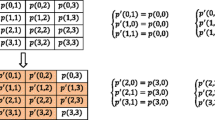Abstract
We investigate the use of parabolic interpolation in data hiding and propose a novel data hiding algorithm with high capacity based on interpolated image. Specifically, the proposed algorithm creates an interpolated image from input image by parabolic interpolation, and embeds secret bits into interpolated pixels in terms of the relation between the interpolated value and the mean value. Ten standard benchmark images are taken as test images for validating efficiency of our algorithm. The results illustrate that our algorithm has better performances than some popular data hiding methods in embedding capacity and visual quality with respect to PSNR and SSIM.













Similar content being viewed by others
References
Alattar AM (2004) Reversible watermark using the difference expansion of a generalized integer transform. IEEE Trans Image Process 13(8):1147–1156
Celik MU, Sharma G, Tekalp AM, Saber E (2005) Lossless generalized-LSB data embedding. IEEE Trans Image Process 14(2):253–266
Chang CC, Tai WL, Chen KN (2008) Lossless data hiding based on histogram modification for image authentication. IEEE/IFIP International Conference on Embedded and Ubiquitous Computing (EUC’08), 1: 506–511
Fallahpour M, Sedaaghi MH (2007) High capacity lossless data hiding based on histogram modification. IEICE Electron Expr 4(7):205–210
Fridrich J, Goljan M, Du R (2002) Lossless data embedding—new paradigm in digital watermarking. EURASIP J Adv Signal Process 2002(2):185–196
Fridrich J, Goljan M, Du R (2002) Lossless data embedding for all image formats. Electronic Imaging 2002. International Society for Optics and Photonics, pp 572–583
Hong W, Chen TS (2011) Reversible data embedding for high quality images using interpolation and reference pixel distribution mechanism. J Vis Commun Image Represent 22(2):131–140
Hu J, Li TR (2015) Reversible steganography using extended image interpolation technique. Comput Electr Eng 46:447–455
Image Databases. [Online] Available: http://www.imageprocessingplace.com/root_files_V3/image_databases.htm
Jung KH, Yoo KY (2009) Data hiding method using image interpolation. Computer Stand Interfaces 31(2):465–470
Jung KH, Yoo KY (2015) Steganographic method based on interpolation and LSB substitution of digital images. Multimedia Tools Appl 74(6):2143–2155
Lee CF, Huang YL (2012) An efficient image interpolation increasing payload in reversible data hiding. Expert Syst Appl 39(8):6712–6719
Lee CC, Wu HC, Tsai CS, Chu YP (2008) Adaptive lossless steganographic scheme with centralized difference expansion. Pattern Recogn 41(6):2097–2106
Liu YC, Wu HC, Yu SS (2011) Adaptive DE-based reversible steganographic technique using bilinear interpolation and simplified location map. Multimedia Tools Appl 52(2-3):263–276
Luo L, Chen Z, Chen M et al (2010) Reversible image watermarking using interpolation technique. IEEE Trans Inf Forensics Secur 5(1):187–193
Ni Z, Shi YQ, Ansari N, Su W (2006) Reversible data hiding. IEEE Trans Circuits Syst Video Technol 16(3):354–362
Sachnev V, Kim HJ, Nam J, Suresh S, Shi YQ (2009) Reversible watermarking algorithm using sorting and prediction. IEEE Trans Circuits Syst Video Technol 19(7):989–999
Tai WL, Yeh CM, Chang CC (2009) Reversible data hiding based on histogram modification of pixel differences. IEEE Trans Circuits Syst Video Technol 19(6):906–910
The SSIM Index for Image Quality Assessment. [Online] Available: http://www.cns.nyu.edu/~lcv/ssim/
Tian J (2003) Reversible data embedding using a difference expansion. IEEE Trans Circuits Syst Video Technol 13(8):890–896
Tseng HW, Chang CC (2008) An extended difference expansion algorithm for reversible watermarking. Image Vis Comput 26(8):1148–1153
USC-SIPI Image Database. [Online] Available: http://sipi.usc.edu/database/
Wang Z, Bovik AC, Sheikh HR, Simoncelli EP (2004) Image quality assessment: from error visibility to structural similarity. IEEE Trans Image Process 13(4):600–612
Wang XT, Chang CC, Nguyen TS, Li MC (2013) Reversible data hiding for high quality images exploiting interpolation and direction order mechanism. Digital Signal Process 23(2):569–577
Wang WJ, Zhang YH, Huang CT, Wang SJ (2013) Steganography of data embedding in multimedia images using interpolation and histogram shiftin., 2013 Ninth International Conference on Intelligent Information Hiding and Multimedia Signal Processing, pp 387–390
Zhang X, Liang T, Tang Z, Dai X (2012) Restoration of embedded image from corrupted stego image. Signal Process 92(7):1691–1698
Acknowledgments
This work was partially supported by the National Natural Science Foundation of China (61562007, 61363034, 61300109), the Guangxi Natural Science Foundation (2015GXNSFDA139040), the Guangxi “Bagui Scholar” Teams for Innovation and Research, the Project of the Guangxi Key Lab of Multi-source Information Mining & Security (13-A-03-01, 14-A-02-02, 15-A-02-02), the Project of the Guangxi Experiment Center of Information Science (20130204), the Guangxi Key Laboratory of Trusted Software (kx201327), the Scientific and Technological Research Projects of Guangxi Education Administration (YB2014048), the Guangxi Higher School Key Lab of Cloud Computing and Complex System (15202), and the Guangxi Collaborative Innovation Center of Multi-source Information Integration and Intelligent Processing. The authors would like to express sincere thanks for the anonymous reviewers’ insightful comments and valuable suggestions.
Author information
Authors and Affiliations
Corresponding author
Rights and permissions
About this article
Cite this article
Zhang, X., Sun, Z., Tang, Z. et al. High capacity data hiding based on interpolated image. Multimed Tools Appl 76, 9195–9218 (2017). https://doi.org/10.1007/s11042-016-3521-0
Received:
Revised:
Accepted:
Published:
Issue Date:
DOI: https://doi.org/10.1007/s11042-016-3521-0




